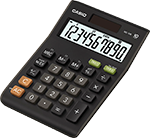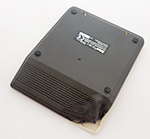Technical data
- Display: 10 digits, LCD
- No. of keys: 26
- Dual power 1×1.5 V SR54 and solar panel
- Size: 146×102×31 mm
- Weight: 100 g
Documents
2021-01-30
Hans' favorite calculator is no longer working after 25 years of duty. He wants to replace it with a similar one. He receives this Casio as a birthday gift.
Costs only 99.90 SEK at Clas Ohlson.
Good
- Solar powered
- Large buttons
Bad
- Nothing







